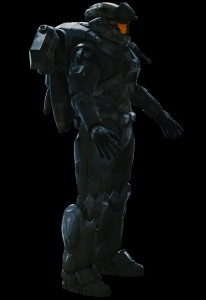For ‘Deliver Hope’, an epic Xbox Halo: Reach spot, Method Studios delivered visual effects for a major battle sequence involving the game’s newest characters. We talk to Method senior creative director and visual effects supervisor Dan Glass about the commercial.
fxg: It’s such a gritty and realistic kind of battle. What was your brief for this spot?
Glass: We were approached very early in the process, back in January or February this year. There was a creative brief from the agency describing the basic story they wanted to tell. In promoting this new game, there were a number of new characters called the Spartans. The central one is Kat. She is carrying a bomb and running through the battlefield to get to this huge cruiser. She gets hit and the significance of that is that in the game she’s missing an arm and has a robotic replacement. Another character, Noble 6, continues the mission by taking the bomb and travelling up to the cruiser via his jetpack. In blowing up the ship we pull back to reveal that it’s part of a vast battle going on along the surface of the planet.
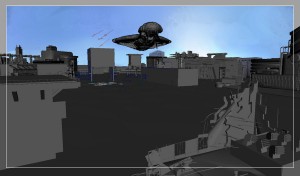
fxg: How did you go about realising these epic kind of scenes?
Glass: It was hugely ambitious for a commercial, both technically and schedule-wise. They approached Noam Murro of Biscuit Films as the director and he came to us because he thought we could achieve the scale of the effects they were after. We did some storyboards, including with Steve Skroce who had worked for the Wachowski brothers who I know well. We quickly went from there into previs with Halon. We had about 10 days to do the previs and build the basic scenes and assets and construct the story. For the large part, the previs was close to what we shot, with the advantage in previs being a lot more freedom in camera, but it was an excellent tool.
fxg: Where was the live action shot?
Glass: We split it into a few distinct chunks for the main battlefield. We had a great location for that in a town called Kladno just outside of Prague. It was an abandoned Eastern Bloc industrial area which was so bizarre, with these vast concrete structures in an old ironworks. It was almost alien and definitely strikingly unusual. It was overgrown with greenery so Noam’s initial reaction was to burn it all off and make it look scarred. They dressed it with bits of wall and burnt out pieces of planes. We shot for two long days with lots of special effects mortar rigs and burning tyres that gave off a black smoke. Then we also shot another day on a greenscreen stage at Studio Barandov.
Most of the live action was shot on film cameras with Steadi-cams and on quad bikes, but we also attached some HD cameras to the helmets of the Marines and on Kat so you get this very first-hand POV feel. To those shots we added HUD graphics somewhat based on the game but with additional detail like honeycomb texture to the screen and stuff that tried to lend it more realism while seeming familiar to those that know the game.
fxg: Were the suits practical or a mixture of real and CG?
Glass: We had Legacy Effects suits that had been built for a previous spot, ‘Birth of a Spartan’, and new suits built for Kat, Noble 6 and the Carter characters. Legacy also built an Elite alien suit which we used for some of the background action and for reference.
fxg: What kind of assets were able to use from the game developer, Bungie?
Glass: We collaborated very closely with the developers of the game who provided some core assets at both low and high qualities. That covered the troops and Spartans and the enemies – Elites, Skirmishes and Grunts. It also included the flying craft – the Banshees and the Falcons. The models were actually very high resolution, but any time they were featured close to camera we upgraded them to add in things like dirt and material properties to make them feel more convincing. We even had animation cycles from the game that we were able to use to quickly populate scenes without enormous requirements for hand-animation at our end. We still refined things because running and walking cycles can become apparent so we would go in and add in variety to those.
The weapon and muzzle flashes and the plasma bolt weapon that shoots Kat was not something the game developer could give us because it’s created in the game engine. They just gave us lots of reference against black and we used that as a basis to match into.
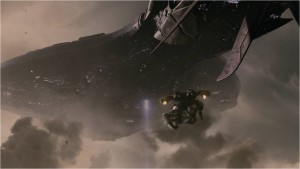 fxg: What were some of the other augmentations you made to the live action?
fxg: What were some of the other augmentations you made to the live action?
Glass: Generally all the enemies and aliens are CG, as are all the flying craft. We also created additional smoke plumes and did sky replacement and effects work to pull out beautiful blue skies from the shoot – yes, clear blue skies, just when you don’t need them. The other details added in the battle were things like tracer and laser fire. It’s a pretty busy spot. The idea was to take you into the battle and have everything going on around you. There was a lot of detailed painting work for the battlefield that we weren’t going to achieve in CG alone. There were lots of layers of smoke, cloud and mist.
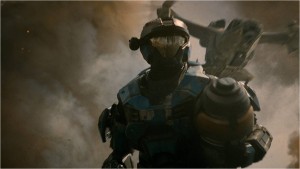 fxg: Can you talk about the jetpack launch and the cruiser shots?
fxg: Can you talk about the jetpack launch and the cruiser shots?
Glass: The take-off and jetpack sequence was something Bungie wanted to feature because it’s a new feature in the Halo: Reach game. Gamers can take on a jet pack and fly around. That sequence was an all-CG character. We built a very hi-res model, and textured it based on the game reference. We hand animated the take-off and flight to the ship.
The interior of the ship was based on a supplied model, but it doesn’t feature strongly in the games and needed quite a bit of work to portray the vast space. So we had to do a ton of CG and matte painting work to achieve the depth of the space and the volumetric lighting. There’s a lot going on in these interior scenes, especially in the longer version of the spot, and there are things you should look out for. When Noble 6 tosses the bomb, he is live action but mostly everything else is CG.
fxg: What about the final pullback shots?
Glass: That’s the fourth major part of the spot with the pull out from the battle – a layered powers of 10 type shot going out into orbit. The explosions were fully CG shots, but in all instances we’d incorporate practical elements and layers in order to lend some detail and credibility to the shots.
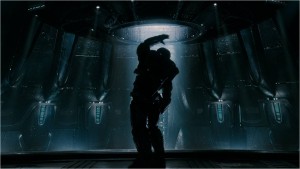 fxg: What were the tools Method relied on for the spot?
fxg: What were the tools Method relied on for the spot?
Glass: We work a lot with Houdini here. The main battle and the cruiser interior and the final explosions were handled through Houdini. The way we brought the game assets and animation cycles in were through Houdini and rendered with RenderMan. For the jetpack sequence with Noble 6, we needed a ray tracer because he had a lot of metal surfaces, so we used a Maya to V-Ray pipeline. We used Nuke for compositing but also ran some shots and elements like the tracer fire through our Flame. All of the conforms were done in Flame too. The close up shots of visors were supplied CG elements put together in Flame. Colour was done at our sister company Company 3.
We chose intentionally at the beginning to treat this as a film project. We scanned it at full 2K instead of just HD and worked on it in film colourspace. Usually for a commercial the colour is supplied at the front end as telecine but we decided to put the colour at the end as a DI grade. For us, it really helps make sure the product holds up in quality at any level of viewing, especially as the full two minute version will be shown in some cinemas.
fxg: Any final thoughts?
Glass: I think one of my guides was to imagine that the piece we were putting together would look like the real world that the game was trying to simulate. The game by its nature is a form of simulation of something so we had to represent a more detailed version of that. And I think it turned out great. The detail you see on some of the cinema projections is just incredible.
Agency: AgencyTwoFifteen
Client: Microsoft XBOX Halo Reach
Executive Creative Director: Scott Duchon
Executive Creative Director: John Patroulis
Art Director: Ben Wolan
Copywriter: Joe Rose
Producer: Joyce Chen
Production Company: Biscuit Filmworks
Director: Noam Murro
Senior Executive Producer: Shawn Lacy
Executive Producer: Colleen O’Donnell
Line Producer: Jay Veal Creative
Post Supervisor: Gary Naccarato
Editorial Company: Rock Paper Scissors
Editor: Angus Wall
Digital Intermediate: Company 3
Color Grading: Stefan Sonnenfeld, Jeremy Sawyer, Siggy Ferstl
Music: Human
Music Producer: Jonathan Sanford
Mix: Lime Studios
Mixer: Loren Silber
Sound Designer: Brian Emrich
Visual Effects: Method
Sr. VFX Supervisor/Creative Director: Dan Glass
DFX Supervisor: Matt Dessero
CG Supervisor: Dan Seddon Sr.
Executive Producer: Gabby Gourrier
Senior VFX Producer: Stephanie Gilgar
CG Lead: Andy Boyd
FX Lead: Doug Bloom
CG Lead: Scott Metzger
Model Lead: Masa Narita
CG Lead: Jeff Willette
Comp Lead: Ryan Urban
Comp Lead: Brian Delmonico
Lead Flame Artist: Noah Caddis

